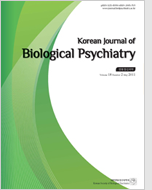
- Past Issues
- e-Submission
-

2021 Impact Factor 1.766
5-Year Impact Factor 1.674
Editorial Office
- +82-01-9989-7744
- kbiolpsychiatry@gmail.com
- https://www.biolpsychiatry.or.kr/

2021 Impact Factor 1.766
5-Year Impact Factor 1.674
Korean Journal of Biological Psychiatry 2015;22(2):47-54. Published online: Feb, 1, 2015
In the past decade, structural, molecular, and functional changes in glial cells have become a major focus in the search for the neurobiological foundations of schizophrenia. Glial cells, consisting of oligodendrocytes, astrocytes, microglia, and nerve/glial antigen 2-positive cells, constitute a major cell population in the central nervous system. There is accumulating evidence of reduced numbers of oligodendrocytes and altered expression of myelin/oligodendrocyte-related genes that might explain the white matter abnormalities and altered inter- and intra-hemispheric connectivities that are characteristic signs of schizophrenia. Astrocytes play a key role in the synaptic metabolism of neurotransmitters ; thus, astrocyte dysfunction may contribute to certain aspects of altered neurotransmission in schizophrenia. Increased densities of microglial cells and aberrant expression of microglia-related surface markers in schizophrenia suggest that immunological/inflammatory factors are of considerable relevance to the pathophysiology of psychosis. This review describes current evidence for the multifaceted role of glial cells in schizophrenia and discusses efforts to develop glia-directed therapies for the treatment of the disease.
Keywords Schizophrenia;Glial cell;Patholphysiology;Therapeutic target.